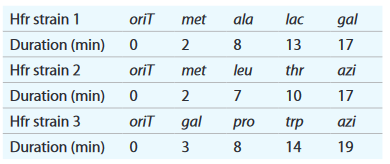
Concept explainers
An interrupted mating study is carried out on Hfr strains

a. For each Hfr strain, draw a time-of-entry profile like the one in Figure
b. Using the chromosome map you prepared in answer to Problem
c. Explain why azi is the last gene of strain
d. Write out the interrupted mating results you would expect after
e. In minutes, what is the total length of the chromosome in the donor species?
Want to see the full answer?
Check out a sample textbook solution
Chapter 6 Solutions
Study Guide And Solutions Manual For Genetic Analysis: An Integrated Approach
- An Hfr strain that is leuA+ and thiL+ was mixed with a strain thatis leuA− and thiL−. In the data points shown in the following graph,the conjugation was interrupted at different time points, and thepercentage of recombinants for each gene was determined bystreaking on a medium that lacked either leucine or thiamine.What is the map distance (in minutes) between these two genes?arrow_forwardDNA from a strain of Bacillus subtilis with genotype a + b + c + d + e + is used to transform a strain with genotype a – b – c – d – e – . Pairs of genes are checked for co-transformation and results shown below are obtained. Based on these results, what is the order of the genes on the bacterial chromosome? Show how you work out the order by diagraming.arrow_forwardAn Hfr strain that is hisE + and pheA + was conjugated to a strain that is hisE − and pheA −. The conjugation was interrupted at different times, and the percentage of recombinants for each gene was determined by streaking on media that lacked either histidine or phenylalanine. The following results were obtained: A. Determine the map distance (in minutes) between these twogenes.B. In a previous experiment, it was found that hisE is 4 minutesaway from pabB and that PheA is 17 minutes from pabB. Drawa genetic map showing the locations of all three genes.arrow_forward
- BACTERIA STRAIN A IS AUXOTROPHIC FOR METHIONINE AND STRAIN B IS AUXOTROPHIC FOR LEUCINE. A. WILL THESE STRAIN GROW ON MINIMAL MEDIUM (A MEDIUM THAT DOES NOT CONTAIN EITHER METHIONINE OR LEUCINE)? B. WHAT TYPE OF GENETIC RECOMBINATION MUST OCCUR TO RECOVER A PROTOTROPH?arrow_forwardWhat is an interrupted mating experiment? What type of experimentalinformation can be obtained from this type of study? Why is it necessary to interrupt conjugation?arrow_forwardIn a conjugation experiment, what is meant by the time of entry? How is the time of entry determined experimentally?arrow_forward
- With respect to F+ and F- bacterial matings, answer the following questions: (a) How was it established that physical contact between cells was necessary? (b) How was it established that chromosome transfer was unidirectional? (c) What is the genetic basis for a bacterium’s being F+?arrow_forwardWith the technique of interrupted mating four Hfr strains were tested for the sequence in which they transmitted a number of different genes to an F strain. Each Hfr strain was found to transmit its genes is a unique sequence, as shown in the accompanying table. What is the gene sequence in the original strain from which these Hfr strains were derived?arrow_forwardAn interrupted mating study is carried out on Hfr strains 1, 2, and 3. After conjugation is established, a small sample of the mixture is collected every minute for 20 minutes to determine the distance between the genes on the chromosome. Times of entry for each of the three Hfr strains studied in the interrupted mating are provided in parenthesis. The total duration of conjugation (in minutes) is given for each transferred gene. Hfr Strain Genes Transferred Hfr 1 oriT(0) met(2) ala(8) lac(13) gal(17) Hfr 2 oriT(0) met(2) leu(7) thr(10) azi(17) Hfr 3 oriT (0) gal(3) pro(8) trp(14) azi(19) Hfr 4 oriT leu met ala lac Hfr 5 oriT trp azi thr leu a. Use the data to construct a circular map of the bacterium.arrow_forward
- In a conjugation experiment, How is the time of entry determined experimentally?arrow_forwardWhen the interrupted mating technique was used withfive different strains of Hfr bacteria, the following orders ofgene entry and recombination were observed. On the basisof these data, draw a map of the bacterial chromosome.Do the data support the concept of circularity?HfrStrain Order1 T C H R O2 H R O M B3 M O R H C4 M B A K T5 C T K A Barrow_forwardThe presence (+) or absence (−) of six sequences in each of five bacterial artificial chromosome (BAC) clones (A–E) is indicated in the following table. Using these markers, put the BAC clones in their correct order and indicate the locations of the numbered sequences within them.arrow_forward
 Biology: The Dynamic Science (MindTap Course List)BiologyISBN:9781305389892Author:Peter J. Russell, Paul E. Hertz, Beverly McMillanPublisher:Cengage Learning
Biology: The Dynamic Science (MindTap Course List)BiologyISBN:9781305389892Author:Peter J. Russell, Paul E. Hertz, Beverly McMillanPublisher:Cengage Learning
